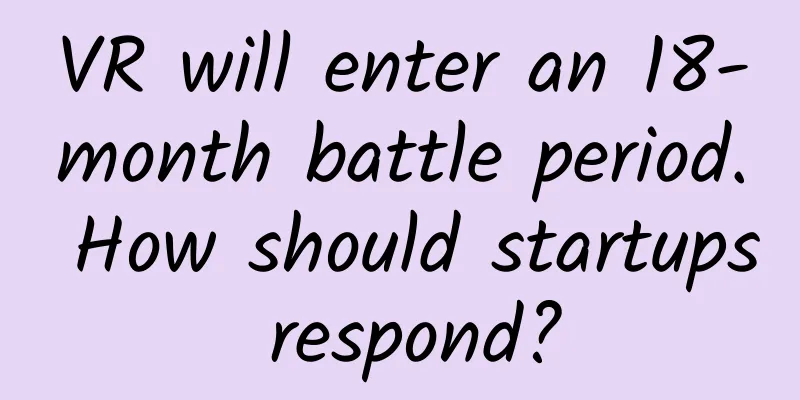VR will enter an 18-month battle period. How should startups respond?

|
February 19th news, if you are one of the virtual reality startups, are you ready to survive the next 18 months of hard work? Former Google, YouTube executive, venture capital partner Ben Smith brought his suggestions. Many VR startups are aware that the path to success in the short term is thorny. The high price of VR equipment has deterred many consumers. We are all looking forward to the future of VR, but it will take a long time before VR enters the homes of millions of people. If you are a VR startup that is in the stage of showing results, raising funds, and promoting, it is very dangerous to develop without a complete roadmap. There is not much time to spend on blind attempts under fierce competition. In the next 18 months of fighting, the following 5 strategies may be helpful to these VR startups: 1. Calculate the risks clearly Users (or revenue) Use Cases data Whenever a new industry emerges, the first arms race that breaks out is often experienced in the competition for users, in other words, the siege of the Internet. It is indeed a wise move to develop as many users as possible, but remember one thing: figure out your purpose. What you need to do is to find real use cases for products and services to solve real market needs. The faster you lock in user needs, the more time you can buy for the company to deliver products, and the greater initiative you can have in the competition. Let's assume that if only enthusiasts use VR products and services at home in the next 18 months, the number of users will be at best not even comparable to that of Snapchat in its early days. Therefore, VR industry startups need to meticulously build data sets to better understand user habits and needs. 2. Lay a solid foundation and build a "moat" It is good to be able to gather users and audiences, but the important thing is how to enhance the stickiness between users and products? How to make users unable to stop using your product? This is a critical aspect that investors value. If you are currently in the fundraising stage, prove to investors why it is the right time to invest now when the market may not emerge until 18 months later. If I were an investor, I would want to know that what we are creating today will be difficult or impossible for others to replicate in the future. The best VR startups should start thinking about user activities and the network effects that grow from them. If you can connect users together or target specific types of activities, you will be far ahead of most competitors in virtual reality startups. 3. Take advantage of VR’s natural advantages When any technology is in its early stages, differences seem like weaknesses until they are proven to be strengths. In other words, it’s best not to blindly emulate older platforms, but to take advantage of VR’s unique strengths. The magic of VR is that it gives us countless different ways of doing things. Even if they seem a bit weird today, it is wise to be good at grasping them. For example, AltspaceVR moved the social interaction in the real world to virtual reality, and it did something that others could not imagine. Therefore, it is reasonable for the company to receive investment from many institutions including Google Ventures and Tencent Fund. 4. Beware of customers who only want gimmicks In the early days of the industry, high-profile brands often approach you for one-off deals, but this usually comes at a high price. For example, stand-up comedian Jimmy Fallon asks you to build the coolest "Fallon VR" experience for him on your platform. If you accept, you will find that in the next few months, you have become Fallon's VR agency and forget your true purpose. Sometimes this short-term deal can add value, but other times it’s a huge drain on resources. How do you determine if it’s worth it? It depends on whether it aligns with your goals and moves your business forward. 5. Learn how to evaluate The best startups know how to measure progress on a weekly basis. You need to know where you are in the food chain at each day or week. Otherwise, you will lose your time strategy. Figure out the exact path to success 18 months from today, and don't let work fall behind! Consider every detail, including metrics, speed, direction, and more. In short, the best startups should know how to build a development roadmap that understands the times, not lose their way because of temporary gains, and know where they are and what level they will reach. (Yunqi) As a winner of Toutiao's Qingyun Plan and Baijiahao's Bai+ Plan, the 2019 Baidu Digital Author of the Year, the Baijiahao's Most Popular Author in the Technology Field, the 2019 Sogou Technology and Culture Author, and the 2021 Baijiahao Quarterly Influential Creator, he has won many awards, including the 2013 Sohu Best Industry Media Person, the 2015 China New Media Entrepreneurship Competition Beijing Third Place, the 2015 Guangmang Experience Award, the 2015 China New Media Entrepreneurship Competition Finals Third Place, and the 2018 Baidu Dynamic Annual Powerful Celebrity. |
<<: Don't talk about Steam Pills, whose heart will be hurt in the end when it goes away
>>: Throw away the controller! Humans are not far from gesture-controlled VR
Recommend
How much does an electrophoresis device cost?
The above person is right, it depends on the size...
Coming next month? Apple iOS 15 has five major features that are really useful
In recent years, Apple's appeal has been decl...
What happened when a welder used melon seed shells to paint and sold them at a high price?
What happened when a welder used melon seed shell...
What is the use of the row of holes on the lower left corner of the iPhone 7 without the headphone jack?
When the iPhone 7 and iPhone 7 Plus were released...
What is the technology behind the popular AI painting? (Part 1)
Making machines creative has always been one of t...
24-hour emergency response: Beijing's flu cases increased by 16.69% year-on-year
Hot News TOP NEWS Beijing CDC: Influenza cases in...
Debunking the “non-myth” in the myth! Is the shark fin of the shark commander in “Nezha 2” really delicious?
In the vast ocean, sharks, known as the "kin...
When you first enter the workplace, how should you do operations work?
The daily operation of an Internet company is the...
The "king of anthocyanins" is not blueberry but this! Eating more can protect the brain, eyes, and inflammation, and can also reduce the risk of coronary heart disease!
Author: Xue Qingxin, registered nutritionist Revi...
"Trimming horse hooves, washing carpets, squeezing blackheads..." Why can't you stop watching these videos?
Produced by: Science Popularization China Author:...
[Creative Cultivation Program] Can "blood washing" therapy help lose weight and lower blood lipids? Dangerous! The truth is...
When the machine starts, the garbage in the blood...
Give birth to a baby quietly during hibernation and surprise all the bears?
Yesterday was Jingzhe. According to tradition, at...
How to write good copy? (I)
The author of this article will combine relevant ...
What kind of value is meaningful to users?
Actual value cannot bring users. What users care ...
360 advertising promotion costs, billing methods, and click prices!
What is the billing method for 360 search promoti...









